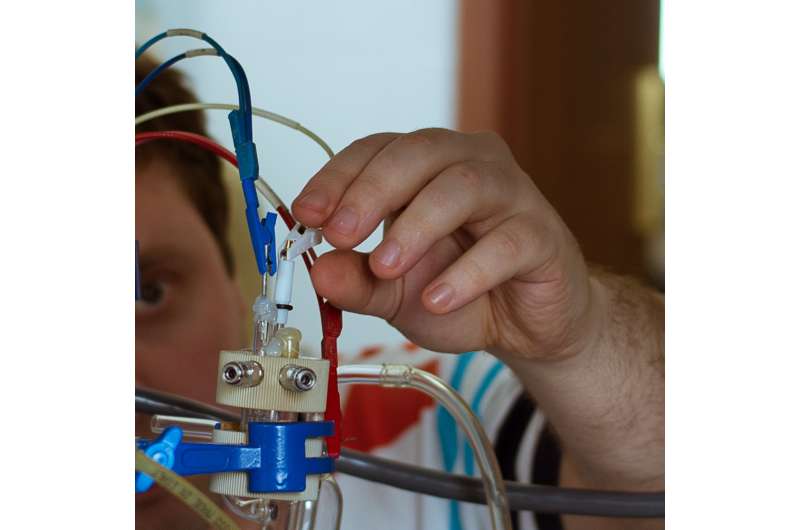How the electrodes of lithium-air batteries become passivated

Lithium-air batteries produce power from air, and are often called lithium-oxygen batteries. They are much lighter than lithium-ion batteries due to higher energy density. Lithium-air batteries have applications including increasing the driving range of electric cars on a single charge. However, despite their advantages, industrial production of lithium-air batteries is inhibited by fundamental problems that can't be overcome at present.
Artem Sergeev, a Ph.D. student from the Department of Polymer and Crystal Physics at the Lomonosov Moscow State University and one the co-authors says, "A lithium-air battery could potentially have three to five times more specific energy than modern lithium-ion batteries. One of the main problems lithium-air battery development is electrode passivation, which is the transition of the electrode material surface into an inactive state. We've obtained new data concerning the reaction mechanism and suggested some ideas on how to inhibit electrode passivation. The technique could be used for more appropriate solvents, electrolytes and electrode materials."
The atmosphere is a mixture of gases, but pure oxygen is required for the operation of lithium-air batteries. Carbon dioxide and moisture in atmospheric gases slow down redox the reactions underlying battery operation. Some estimates suggest overcoming these obstacles will take from five to10 years. The scientists from the Lomonosov Moscow State University are studying the processes preventing robust operation of lithium-air batteries.
Alexei Khokhlov, one of the authors, says, "Generally, in the case of elaboration success, the battery should be lithium-air, implying usage of environmental air. Special membranes could separate the undesirable atmospheric components including moisture and carbon dioxide. But currently, there are also more fundamental problems, and in order to solve them, we use lithium-oxygen cells and deliver pure oxygen from gas bottles."
The cathode (a positive electrode) in a lithium-air battery is represented by a porous carbon sponge containing the electrolyte solution with lithium ions. The cathode has contact with the outside gas environment, which is necessary to provide oxygen delivery to the electrolyte, which is a liquid ion conductor. The scientists simulated the interface between the electrode and electrolyte solution at the cathode of a lithium-air battery and offered an approach for inhibiting electrode passivation. The researchers used the supercomputer complex of the Lomonosov Moscow State University for all-atom simulation with the help of molecular dynamics methods.
Alexei Khokhlov says, "There is a large number of parallel processes and reactions occurring at the cathode during lithium-air battery operation. Unfortunately, experimental study of the separate stages of these processes often turns out to be impossible, while simulation of separate stages of the reactions with the help of supercomputers allows tracing basic trends in the stages we're studying."
The scientists have found out that reduction of superoxide anions leading to electrode passivation is possible only after its binding with lithium cations.
Alexei Khokhlov sums up: "We've understood that formation of non-conductive discharge products right on the electrode surface (its passivation) takes place only after binding of an intermediate (superoxide anion) with lithium ions, which are highly concentrated near the electrode surface. If you displace them, passivation won't, probably, proceed so rapidly."
More information: Artem V. Sergeev et al, Electrode/Electrolyte Interface in the Li–O2 Battery: Insight from Molecular Dynamics Study, The Journal of Physical Chemistry C (2017). DOI: 10.1021/acs.jpcc.7b03861
Journal information: Journal of Physical Chemistry C
Provided by Lomonosov Moscow State University



















